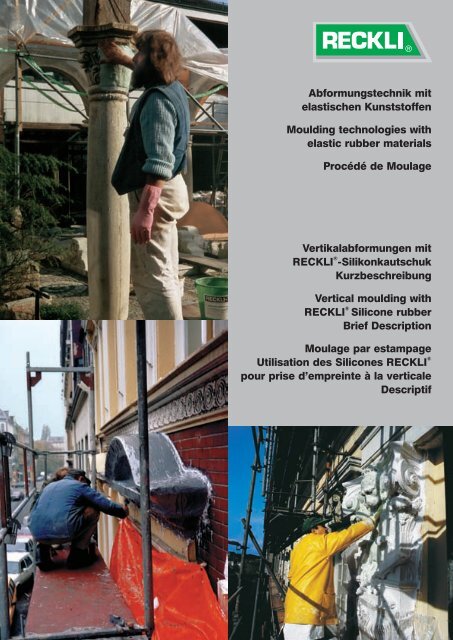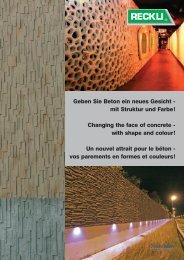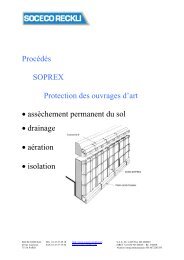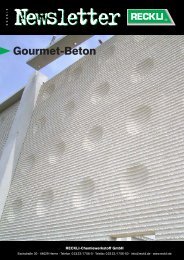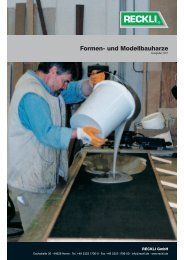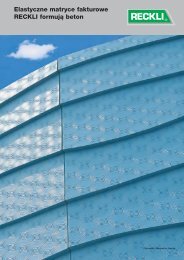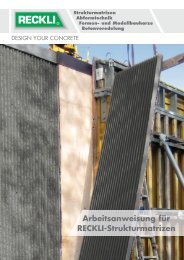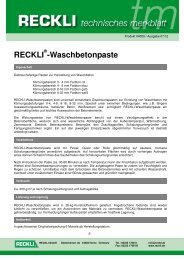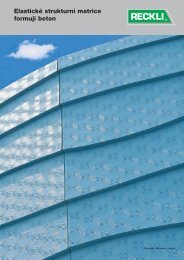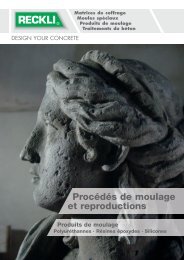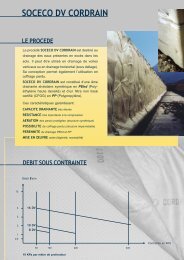Abformungstechnik mit elastischen Kunststoffen Moulding ...
Abformungstechnik mit elastischen Kunststoffen Moulding ...
Abformungstechnik mit elastischen Kunststoffen Moulding ...
- Keine Tags gefunden...
Erfolgreiche ePaper selbst erstellen
Machen Sie aus Ihren PDF Publikationen ein blätterbares Flipbook mit unserer einzigartigen Google optimierten e-Paper Software.
<strong>Abformungstechnik</strong> <strong>mit</strong><strong>elastischen</strong> <strong>Kunststoffen</strong><strong>Moulding</strong> technologies withelastic rubber materialsProcédé de MoulageVertikalabformungen <strong>mit</strong>RECKLI ® -SilikonkautschukKurzbeschreibungVertical moulding withRECKLI ® Silicone rubberBrief DescriptionMoulage par estampageUtilisation des Silicones RECKLI ®pour prise d’empreinte à la verticaleDescriptif
1 2RECKLI-SI-Trennlack <strong>mit</strong> einem weichen Pinsel aufstreichenApply RECKLI Si Stripping varnish with a soft brushApplication de la Laque de protection RECKLI-SiForm <strong>mit</strong> RECKLI-Si-Abformpaste HR-N bestreichen ohne VerdickerPaint mould with RECKLI-Si-Mould Paste HR-N without ThickenerCouche d’impression, Pâte d’estampage RECKLI SI HR-N sans Additif thixo -tropantModellvorbereitungGrundsätzlich müssen alle abzuformendenModelle trocken, sauber, staubfrei und tragfähigsein.RECKLI-Silikonkautschuk ist selbsttrennend.Saugfähige Untergründe sollten je -doch generell abgesperrt werden, um eineFarbänderung durch eindringendes Silikon -öl sowie Oberflächenstörungen in der Sili -konform zu vermeiden. In solchen Fällenempfehlen wir, vor der Abformung das Mo -dell <strong>mit</strong> RECKLI-SI-Trennlack zu bestreichen.(Bild 1)Im Regelfall wird die abzunehmende Formauch einen Rand oder Rahmen erhaltenmüssen, so dass auch die Randbereiche zubehandeln sind.RECKLI-SI-Trennlack ist wasserlöslich undkann nach der Abformung leicht und ohneRückstände wieder vom Original abgewaschenwerden.RECKLI-SI-Trennlacktransparenter Trennlack in wässriger Lö -sung, schnelltrocknend, abwaschbarVerbrauch: ca. 200-250 g/m 2 je nach Be -schaffen heit des UntergrundesAuf metallischen (z. B. Eisen, Aluminium)oder keramischen Oberflächen (z. B. Glas,Fliesen, Porzellan, Beton, Granit, Silikat -farben) kommt es in wenigen Fällen zuAnhaftungen. Diese lassen sich durchAuftragen von RECKLI-Formenwachs vermeiden.RECKLI-Formenwachslösungs<strong>mit</strong>telhaltige Edelhartwachs dis per -sionVerbrauch: ca. 50-100 g/m 2Model preparationAs a general rule, all models which are to bestripped must be dry, clean, free of dust andcapable of being loaded.RECKLI Silicone rubber is self-stripping.Nevertheless absorbing surfaces are to besealed to avoid discoloration by penetratingsilicone oil and inhibitions in the front of thesilicone mould. In such cases we recommendthe application of RECKLI SIStripping Lacquer before pasting on orcasting the silicone rubber. (picture 1).Generally the mould will have to be providedwith a border or frame. Therefore theseareas must also be treated.RECKLI SI Stripping Lacquer is water-solubleand can easily be washed off residuefree from the original after the strippingprocess.RECKLI SI Stripping Lacquertransparent, aqueous stripping varnish, fastdrying, can be washed off.Quantity required: approx. 200-250 g/sqmdepending on absorptive strength of thefoundation.In some cases there might occur an adhesionof the silicone rubber to surfaces ofmetal e.g. iron, aluminium or other materialslike ceramics, glass, porcelaine, concrete,granite and silicate paint. In these casesyou can achieve a sufficient separation byusing RECKLI Mould Wax.RECKLI Mould Waxsolvent-containig dispersion of a precioushard wax.Quantity required: approx. 50 -100 g/sqm.Préparation du modèleDe manière générale, tous les modèles àmouler doivent être secs, propres, exemptsde poussière et solides.Le silicone RECKLI est auto-démoulant.Cependant, les supports absorbants doiventen principe être calfeutrés, afin d’éviterune décoloration due à la pénétration d’huilede silicone ou des problèmes de surfacedans le moule de silicone. Dans de tels cas,avant le moulage, nous recommandonsd’appliquer sur la pièce de la laque de protectionRECKLI SI. (Illustration 1).La forme à reprendre est en général dotéed’un bord ou d’un cadre et par conséquent,un traitement de ces zones est égalementnécessaire.La laque de protection RECKLI SI estsoluble à l’eau et après le moulage, ellepeut être facilement retirée de l’originalsans laisser de traces.Laque de protection RECKLI SILaque séparatrice transparente en solutionaqueuse, séchant rapidement et lavableUtilisation: env. 200-250 g/m 2 selon le supportSur des surfaces métalliques (par ex., enfer ou en aluminium) ou bien en céramique(par ex., en verre, carrelage, porcelaine,béton, granit ou en peinture au silicate) desadhérences peuvent se produire dans certainscas rares. L’application de la cire dedécoffrage RECKLI permet d’éviter cesadhérences.Cire de décoffrage RECKLIDispersion de cire liquide solvantée dehaute qualitéUtilisation : env. 50-100 g/m 22
34Erste Spachtelung <strong>mit</strong> pigmentierter Reckli-Si-AbformpasteFirst application of pigmented RECKLI Si Paste with smoothing trowelPremière couche d’estampage, Silicone RECKLI avec incorporation depigmentsSi-Spachtelung <strong>mit</strong> der Hand verschlichtenSmooth Si Paste by handEgalisation á la mainElastische Abformung <strong>mit</strong>RECKLI-SilikonkautschukNach der Vorbereitung des Untergrundeswird nun in mehreren Schichten RECKLI-SI-Abformpaste HR-N aufgetragen. ImFolgenden wird ein dreischichtiger Aufbaudargestellt.Für Arbeiten im senkrechten oder Überkopfbereichwird die Konsistenz desSilikons durch zusätzliche Zugabe vonRECKLI-SI-Verdicker flüssig K als dritterKomponente bedarfsgerecht eingestellt. ZurErzielung eines dichten, von Luftein -schlüssen freien Silikonüberzugs empfiehltes sich, die erste Schicht ohne oder <strong>mit</strong> nurgeringem Zusatz von Verdicker (= 0,3 %)aufzutragen. Es lässt sich so eine Kon -sistenz einstellen, bei welcher die Silikon -masse noch einen Rest an Fließfähigkeitbesitzt und bis zu einer Schichtstärke vonca. 1 mm in der Vertikalen abläuft. (Bild 2)Wenn die erste aufgetragene Schicht soweitabgebunden ist, dass ein Folgeauftrag sienicht mehr verschieben kann, wird RECKLI-SI-Abformpaste HR-N nun <strong>mit</strong> Zugabe einergrößeren Menge Verdicker (= 1,5 %) inmöglichst gleichmäßiger Stärke bis zu ca. 5mm in einem Arbeitsgang aufgetragen.(Bild 3) Der Auftrag ist auch dann ohnezusätzliche Vorarbeiten möglich, wenn dievorangehende Silikonschicht vollständigdurchgehärtet ist.Durch Zugabe von RECKLI-SI-Farbpastelässt sich zudem das Silikon einfärben.Dadurch ist leicht zu verfolgen, in welchenBereichen jeweils bereits Silikon aufgetragenwurde.Abschließend wird <strong>mit</strong> der Hand, die durcheinen dünnen Gummihandschuh zu schützenist, die aufgespachtelte SI-Abformpasteverschlichtet. (Bild 4) Anfeuchten desGummihandschuhs <strong>mit</strong> klarem Wasser oderElastic <strong>Moulding</strong> usingRECKLI Silicone RubberAfter the preparation of the surface nowRECKLI SI Mould Paste HR-N is applied inseveral layers. In this description a threelayer process is shown.For working in the vertical or overhead areathere must be added RECKLI SI ThickenerLiquid K as a third component to reach theright consistency for each special afford. Toobtain a tight silicone rubber coat free of airbubbles we recommend to paint the firstlayer with a brush adding just a smallamount of the liquid thickener (= 0,3 %).This is yielding a consistency, in which thesilicone is still flowing, leaving a layer ofabout 1 mm in the vertical area (picture 2).After the applied first coat has set sufficientlyso that the following layer can nolonger displace it, RECKLI SI Mould PasteHR-N is now applied in one operation in athickness as even as possible to a maximumthickness of about 5 mm. Therefore alarger amount of RECKLI SI ThickenerLiquid K (= 1,5 %) is necessary (picture 3).Nonetheless the former silicone coat hascured completely, another silicone layercan be applied without additional operationsgetting a perfect bonding to the formerlayer.By adding RECKLI SI Colour Paste it is possibleto colour the silicone to a light pastelgreen. So it is easier to observe, in whichareas the actual layer has already beenapplied.Finally the applied mould paste has to besmoothened by hand (picture 4). The handis to be protected by a thin rubber glove.Dampening the rubber glove in clear wateror soapy water prevents adhesion and facilitatesthis process.Moulage élastiqueavec le silicone RECKLIUne fois la préparation du support termi née,la pâte d’estampage RECKLI SI HR-N estappliquée en plusieurs couches. Une applicationde trois couches est ici représentée.Pour les travaux à la verticale ou en surplomb,la consistance du silicone est adaptéeen ajoutant au besoin un troisième composant,en l’occurrence, l’additif thixotropantRECKLI de type K. Pour une coucheépaisse de silicone sans air occlus, il estconseillé de ne pas appliquer d’additifthixo tropant sur la première épaisseur oubien seulement une petite quantité (= 0,3%). Ceci permet d’obtenir une consistancedu silicone avec encore une certaine fluidité,laissant une épaisseur de couche d’env.1 mm à la verticale. (Illustration 2).Lorsque la première couche appliquée asuffisamment pris de sorte que l’applicationsuivante ne peut plus la déplacer, la pâted’estampage RECKLI SI HR-N est alorsappliquée en une opération, avec une grandequantité d’additif thixotropant (= 1,5 %),de façon aussi régulière que possible jusqu’àune épaisseur maximale d’env. 5 mm(Illustration 3). Cette application est égalementpossible sans travail supplémentaire,à condition que la couche de silicone précédentesoit parfaitement durcie.De plus, l’ajout d’une pâte coloranteRECKLI SI permet de teindre le silicone. Àcet effet, il est facile de distinguer les partiessur lesquelles le silicone a déjà étéappliqué.Ensuite, avec la main protégée par un ganten caoutchouc fin, lisser la pâte d’estampageSI. (Illustration 4). L’humidification dugant en caoutchouc avec de l’eau claire ouune solution savonneuse permet d’éviterune adhérence et facilite cette opération.3
5 6Zweite Si-Spachtelung, weißSecond Si Paste application, white, without pigmentDeuxième couche d’estampage (non colorée)Fixierungsstreifen in die zweite Spachtelung einbetten und anformenEmbed and adjust fixing strip in second trowellingMise en place des profils de positionnementSeifenlösung verhindert ein Anhaften underleichtert diesen Arbeitsschritt.RECKLI-SI-Abformpaste HR-Nstreich- und spachtelbarer Zweikompo nen -ten-Silikonkautschuk, raumtemperaturvernetzendVerbrauch: ca. 1,1 kg/m 2 je mm Schicht -stärkeIm Doppelgebinde ferner enthalten:RECKLI-SI-Verdicker flüssig KThixotropier<strong>mit</strong>telDosierung: 0,1 - 1,5 %RECKLI-SI-Farbpastegrün, Dosierung ≤ 1 %Auch vor dem Auftragen der ab schließen -den dritten Schicht ist darauf zu achten,dass der vorherige Silikonauftrag soweitdurchgehärtet ist, dass ein Verschiebendurch die weitere Spachtelung nicht mehrmöglich ist. (Bild 5)Um der <strong>elastischen</strong> Silikonform später inder starren Stützform einen guten Sitz undeine optimale Fixierung zu geben, werden inden letzten frischen Spachtelauftrag imRandbereich oder in der Fläche Profil -schnüre, Streifen oder Noppen aus Silikoneingebettet und angearbeitet, die zuvorseparat angefertigt wurden. (Bild 6)Diese Profilierungen vermeiden gleichzeitigauch ein Verrutschen der <strong>elastischen</strong> Formin der Stützform während des Füllvor -ganges für die Reproduktion des Originals.Achtung! Direkter Kontakt unterschiedlicherSilikonelastomere kann, bedingt durchWeichmacherwanderung, zu Verformungenoder verstärktem Ausbluten der Silikonformführen. Achten Sie in jedem Fall darauf,dass weder innerhalb ein und derselben4RECKLI SI Mould Paste HR-Ntwo component silicone rubber, applicationby brush or by trowel, room temperaturecuring.Consumption: approx. 1,1 kg/sqm per mmlayer thickness.Also included in the drum:RECKLI SI Thickener Liquid KThixotropic agentDosage: 0,1 – 1,5 %RECKLI SI Colour Pastegreen, Dosage ≤ 1 %As before this layer must also have set sufficientlyso that it can not be displaced bythe final third coat (picture 5).In order to give the elastic silicone mould agood fit and optimal fixing qualities later inthe solidified supporting mould, profilecords, strips or burls of RECKLI SI MouldPaste HR-N, made separately before-hand,are bedded and worked into the border orthe surface of the final fresh coat of siliconerubber (picture 6).At the same time these profiles also preventthe elastic mould from slipping in the supportingmould during the casting process ofthe reproduction of the original.Attention! Direct contact of silicone rubbersof a different kind may lead to deformationor bleeding of the silicone mouldcaused by migration of plasticizer. Pleaseobserve in any case, that silicon rubber ofdifferent types must not let come into directcontact with oneanother, neither within onemould nor during storing moulds later on.With this final application care must betaken to level undercuts, burls and edges insuch a way that there are no constrictivepositions when the supporting mould isPâte d’estampage RECKLI SI HR-NCaoutchouc silicone à deux composantsapplicable au pinceau ou à la spatule, réticulationà température ambianteUtilisation: env. 1,1 kg/m 2par mm d’épaisseurde coucheÉgalement compris dans le pot :Additif thixotropant RECKLI type KAgent thixotropantDosage 0,1 - 1,5 %Pâte colorante RECKLI SIde couleur verte, dosage ≤ 1 %Même avant l’application de la troisième etdernière couche, il convient de vérifier quela couche de silicone précédente est durcieet empêche tout déplacement dû à unenouvelle enduction. (Illustration 5).Afin de garantir ultérieurement au moule desilicone élastique une bonne tenue et unefixation optimale dans l’ossature solidifiée,des cordes de profil ou des bandes en siliconepréformés seront plaqués à la périphériedu moulage encore pâteux.(Illustration 6)Ces profils éviteront également tout déplacementdu moule dans son support lors ducoulage des épreuves.Attention! Le con tact direct de différentsélastomères de silicone, peut selon lamigration de plastifiant, entraîner des déformationsou des étalements du moule desilicone. Vérifiez impérativement que, dansun seul et même moule ou bien lors dustockage ultérieur, les différents types decaoutchouc de silicone n’entrent pas encontact direct!Pour la dernière enduction, il importe detraiter les détails, arêtes et bords de façonà ce qu’aucun point de contrainte n’appa-
78Unterschneidungen, Grate und Kanten konisch bearbeiten und glättenBevel and smooth undercuts,fins and edgesEgalisation, suppression des contredépouillesAbsperrungen für die 2-teilige Stützform aufkitten und FührungsprofilierungeneinschneidenCement shut offs for 2-piece support mould and cut guiding profilesBande d’arrêt, dècoupe des guides d’assemblageForm noch bei der späteren LagerungSilikonkautschuk unterschiedlicher Typenuntereinander in direkten Kontakt kommt!Beim Auftragen der letzten Spachtelungkommt es darauf an, Unterschneidungen,Grate und Kanten konisch beizuarbeiten, sodass für die später aufzubringendeStützform keine Zwängungspunkte entstehen.Dies erfolgt wiederum <strong>mit</strong> der Hand,geschützt durch einen dünnen Gummi -handschuh. (Bild 7)Bei groben Hinter- oder Unterschneidungenoder auch Durchbrüchen empfehlen wirdas Setzen von Plomben oder Keilen ausRECKLI-Epoxi-GF-Spachtel, oder einemehrteilige Ausführung der Form.Herstellung der Stützform ausRECKLI-Epoxi-GF SpachtelNach dem Erhärten der letzten Silikon -kautschuk schicht wird die Stützform ausRECKLI-Epoxi-GF Spachtel her gestellt. Umeine sichere Trennung zwischen der Stütz -form und der <strong>elastischen</strong> Silikon kaut -schukform zu erreichen, wird auf dieSilikonkautschukflä che <strong>mit</strong> einem Pinselzweimal gleich mäßig deckend RECKLI-Formenwachs aufgestrichen. Der ersteWachsauftrag muss völlig abgelüftet sein,bevor der zweite erfolgen kann.RECKLI-Formenwachslösungs<strong>mit</strong>telhaltiges Trenn<strong>mit</strong>tel zur sicherenTrennung von <strong>Kunststoffen</strong>Verbrauch: ca. 100-200 g/m 2Der Wachsfilm muss völlig abgelüftet undtrocken sein, bevor die weiteren Arbeits -gänge erfolgen.Je nach Art des abzuformenden Origi nalsund seiner Kompliziertheit kann es erforlaterapplied on. This can be done by hand.The hand must be protected by a thin rubberglove again (picture 7).Where there are oversized rear cuts andundercuts or gaps we therefore recommendapplying seals or wedges made of RECKLIEpoxy GF Filler. Another possibility is toconstruct the mould in several pieces.Making the supporting mouldusing RECKLI Epoxy GF FillerWhen the last silicone rubber layer has set,the supporting mould is made usingRECKLI Epoxy GF Filler. To achieve sureseparation of the support ing mould and theelastic silicone rubber mould, two equalcoats of RECKLI Mould Wax are brushedevenly onto the silicone rubber surface.Thefirst coat of wax must be completely evaporatedbefore the second coat can beapplied.RECKLI Mould WaxSolvent-containing stripping agent for thesure separation of plasticsQuantity required: approx. 100-200 g/sqmThe wax film must be completely evaporatedand dry before the ensuing operationscan be commenced.Depending on the nature of the original andthe difficulties involved with stripping, it maybe necessary to construct the supportingraisse pour l’ossature à appliquer ultérieurement.Ceci est de nouveau effectué avecla main, protégée par un gant en caoutchoucfin. (Illustration 7).En cas de détails importants et autrescontre-dépouilles ou percées, nous recommandonsd’appliquer des plombs ou descoins composés de Masticoque RECKLI-Epoxi GF ou d’utiliser une exécution dumoule en plusieurs pièces.Fabrication de la chape supporten Masticoque RECKLI Epoxi-GFLe caoutchouc Silicone doit être parfai -tement polymérisé. Pour obtenir une séparationefficace entre le moule souple et sonsupport, il est nécessaire d'appliquer à lasurface du silicone deux couches régulièresde Cire de décoffrage RECKLI.Chaque couche doit être parfaitementsèche avant toute autre intervention.Cire de décoffrage RECKLICire contenant un solvant,agent séparateur pour matièressynthétiquesConsommation: env. 100 à 200 g/m 2Selon la configuration de l'original et sacomplexité, il peut être nécessaire de réaliserle support en deux parties ou plus.Pour concrétiser les lignes de séparationdu support, on peut utiliser du mas tic devitrier ou de l'argile. Des pro fils seront taillésdans l'épaisseur de l'argile pour constituerdes guides d'assemblage (fig. 8).5
9 10RECKLI-Epoxi-GF Spachtel als Stützform aufspachtelnApply supporting mould of RECKLI-Epoxy-GF Filler by trowelConfection du support en Masticoque RECKLI Epoxi-GF2-teilige Stützform <strong>mit</strong> angeformtem Führungsprofil abnehmenRemove 2-piece supporting mould with guiding profileSéparation et extraction des demi-coquillesderlich sein, die Stützform zwei- oder mehrteiligauszubilden.Für die dann erforderliche Absperrung derFormenteile wird handelsüblicher Fenster -kitt oder Ton verwendet. In den Kitt werdenProfilierungen eingeschnitten, die als Füh -rungsleisten beim Zusammensetzen derFormenschalen dienen. (Bild 8)Danach wird RECKLI-Epoxi-GF Spachtel ineinem Arbeitsgang bis zu 5 mm dick aufgespachtelt.(Bild 9)Zur Aussteifung und Stabilisierung könnenin die frische Spachtelmasse Leisten,Hohlprofile, Schaumstoffschnüre oderGewebestreifen eingebettet werden.RECKLI-Epoxi-GF Spachtelzweikomponentiger, lösungs<strong>mit</strong>telfreier, na -hezu schrumpffreier, glasfaserverstärkterKunststoffspachtelVerar bei tungszeit: ca. 15 MinutenVerbrauch: je mm Schichtstärke ca. 1,25 kg/m 2Nach dem Erhärten von RECKLI-Epoxi-GFSpachtel wird die daraus hergestellteStützform entformt. (Bild 10)Zur Vermeidung von Verletzungen an denscharfen Kanten und vorstehenden Glas -fasern sollte die Form <strong>mit</strong> Sandpapier entgratetund geschliffen werden. Danach könnendann noch Hohlprofile, Winkelleisten,Kanthölzer oder Latten zur Aussteifung undGurtung der Gesamtform wiederum <strong>mit</strong>RECKLI-Epoxi-GF Spachtel angespachteltwerden. (Bild 12)Hierdurch wird auch die ausreichendeStandsicherheit der kompletten Form beimFüllen gegeben. Um einen kraftschlüssigenVerbund zu erreichen, müssen die anzuspachtelndenProfile selbstverständlich öl-,fett- und wachsfrei sein und die Haftpunkte6mould in two or more sections. Commer -cially available window putty or clay is usedfor the neces sary shutting off of the mouldsections. Profiles are cut into the putty andserve as guiding rails when connecting themould shells (Pict. 8).Following this, RECKLI Epoxy GF Filler isapplied in one stage to a maximum thick -ness of 5 mm (Pict. 9).For stiffening and stabilizing, it is possible toembed blocks, hollow sections, foam-rubbercords or webbing strips in the freshputty.RECKLI Epoxy GF Fillertwo-component, solvent-free practical lyshrinkage-free fibreglass-reinforced plasticfillerWorkable time: approx. 15 minutesQuantity required: per mm layer thicknessapprox. 1.25 kg/sqmWhen the RECKLI Epoxy GF Filler has hardened,the resulting supporting form isdeshuttered (Pict. 10).In order to avoid injuries caused by thesharp edges and protruding fibre glass, themould should be deburred and smoothedusing sand paper. Following this, hollowsections, angled blocks, wooden edges orstrips for the stiffen ing or ribbing of thecomplete mould can still be filled in usingRECKLI Epoxy GF Filler (Pict. 12).This also ensures the adequate stability ofthe complete mould when pouring. Toobtain strong adhesion, the sections to befilled must, of course, be oil -, grease- andwax-free and the adhesive points on thesupporting mould must be roughened usingsand paper.Le Masticoque RECKLI Epoxi-GF sera alorsappliqué par couches succes sives de 5mm d'épaisseur (fig. 9).Pour raidir la coque, on peut incorporerdans le Masticoque RECKLI Epoxi-GFencore pâteux, des profils métalliques, boisou des tissus de renforcement.Masticoque RECKLI Epoxi-GFmastic synthétique à deux composantssans solvant, à très faible retrait, renforcéde fibres de verre.Ouvrabilité: env. 15 minutesConsommation: env. 1,25 kg/m 2par mmd'épaisseurAprès durcissement du MasticoqueRECKLI Epoxi-GF, la coque sera sépa réedu moule souple (fig. 10).Les pièces seront ébavurées au papier deverre pour éviter tout risque de blessure surles arêtes vives ou les fibres apparentes. Onpourra alors en profiter à l'aide duMasticoque Epoxi-GF pour fixer un piètementdestiné à assurer la stabilité de l'ensemble(fig. 12).Pour des raisons de bonne adhérence, lespièces rapportées devront bien évidemmentêtre exemptes d'huile, de graisse oude cire et dépolies au papier abrasif.
1112Elastische Silikonkautschukmatrize vorsichtig abziehenCarefully peel off elastic silicone rubber matrixDémoulage de la matrice élastiqueFertige Stützform <strong>mit</strong> angespachteltem Holzrahmen und eingelegterSilikonkautschukmatrizeFinished supporting mould complete with wooden frame and insertedsilicone rubber matrixMoule prêt à l’emploi, muni de renforts stabilisateursan der Stützform durch Schleifen <strong>mit</strong>Sandpapier aufgeraut werden.Entformen der <strong>elastischen</strong>SilikonkautschukformNach dem Abnehmen der Stützform wirddie elastische Silikonkautschukmatrize entformt.Dabei ist darauf zu achten, dass sienicht <strong>mit</strong> Gewalt vom Urmodell abgezogenwird, sondern je nach Formgebung aus denUnterschneidungen und Versatztiefen zu -nächst langsam und vorsichtig unter Aus -nutzung der Dehnung des Silikons herausgewundenund dann insgesamt vom Modellabgezogen wird. (Bild 11)Um Deformierungen und Beschädigungenan der Silikonform zu vermeiden, sollte siezur Lagerung und Aufbewahrung immerwieder in die Stützform eingelegt werden(Bild 12).Als Abgussmaterialien für die Kopien eignensich Beton, Mörtel, Gips aber auch verschiedeneKunststoffe. Bitte fordern Sieunsere Beratung an.Lagerung der SilikonformenGenerell gilt, dass Formen aus kondensationsvernetztenSilikonen nicht für die Ewig -keit bestimmt sind. Sie unterliegen einemfortschreitenden Alterungsprozess, der sichin einem kon tinuierlichen Schrumpf undOber flächen veränderungen zeigt.Es sollte deshalb immer das Original oderz.B. ein Replikat aus Gips aufbewahrt werden,um hiervon schnell und kostengünstigwieder eine Abformung zu machen.Sollten Formen unbedingt länger aufbewahrtwerden müssen, so empfehlen wir,additionsvernetze Silikone zu verwenden,z.B. RECKLI-Silikone der Reihe AV oder aufdie besonders lager stabilen RECKLI-PUR-Elastomere auszuweichen.Deshuttering of the elasticsilicone rubber mouldAfter removing the supporting mould, theelastic silicone matrix is stripped. Care mustbe taken not to use force when removingthe matrix from the ma ster mould. Depen -ding on the form, it should first be slowlyand carefully loos ened away from theundercuts and offset recesses, takingadvantage of the elasticity of the silicone.The matrix should then be peeled from themould completely (Pict.11).In order to prevent deforming and damageto the silicone mould, it should always bereplaced in the supporting mould when notin use or when stored (Pict. 12).Concrete, mortar, plaster of Paris and variousplastics are suitable as materials for theproduction of copies. Please consult ouradvice service.Storage of silicone mouldsIn general one can say that condensationcuredsilicone moulds do not have an everlastinglife. They are suffering under a progressiveageing process, which shows acontinuous shrinkage as well as changes ofthe surface.Therefore we recommend to keep alwaysthe original mould, or for example a gypsumreplica, to make a quick and reasonablecasting possible at any time.In case the moulds must be kept longer, wesuggest to work with addition-cured siliconese.g. RECKLI-silicones of our line AVor to choose our especially store-stableRECKLI-PUR-Elastomeres.Démoulage de la matriceen caoutchouc SiliconeLe démoulage de la matrice élastique devrase faire en douceur, sans forcer en profitantde l'élasticité du silicone pour extraire lesendroits difficiles ou en contre dépouilles(fig. 11).Pour éviter toute déformation définitive dumoule, veiller toujours à le repositionnerdans son support (fig. 12).Lors du tirage des épreuves, on peut utiliserdes matériaux tels que béton, plâtre, mortierou diverses matières synthétiques. A cesujet, veuillez nous consulter.Entreposage des moulesen siliconeEn général les moules en silicone polycondensationn’ont pas une durée d’utilisationilli<strong>mit</strong>ée. Ils souffrent de l’usure du temps,ceci se manifestant par un rétrécissementcontinuel et une altération de la surface.C’est pourquoi il faut toujours conserverl’original ou bien, par exemple, une copieen plâtre, afin d’être en mesure de refaireun moulage rapide et bon marché.Dans le cas où les moules doivent obligatoirementêtre conservés plus long temps, nousconseillons l’utilisation de silicones polyaddition,par exemple les silicones RECKLI de lagamme AV, ou bien encore de nos robustesElastomères Poly urethanne RECKLI.7
Unser Produktionsprogramm Wiederverwendbare Strukturmatrizen 1x-Schalungen Polyurethan-Elastomere für Abformungen Silikon-Elastomere für Abformungen Formen- und Modellbau-Harze Versiegelungen Trenn<strong>mit</strong>tel Schlauch- und Kabelbrücken aus PUROur product range Reusable Formliners One-Timer Formliners Polyurethane Rubbers Silicones for Mould and Pattern Making Cold Cure Resins for <strong>Moulding</strong> & Modelling Sealants Release Agents Hose & Cable Tunnels made from PURNotre gamme de produits Matrices de coffrage multi-usage Matrices 1 emploi Elastomères Polyuréthanne Elastomères Silicone Résines Epoxy Vernis Agents de démoulage Pontets de protection PU pour câbles et tuyauxStrukturmatrizenAbformtechnikFormen- undModellbauharzeRECKLI GmbHAdresse/Address: Eschstraße 30 44629 Herne Germany Tel. +49 2323 1706-0 info@reckli.dePostadresse/Mailing Address: Postfach 1013 29 44603 Herne Germany Fax +49 2323 1706-50 www.reckli.de0110 / 11/10 / MW


